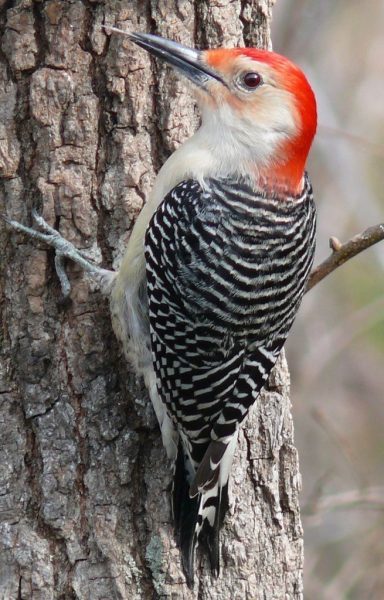Information About The Bird
Seen/Heard at
Decorah, Decorah North
Diet
The Red-bellied Woodpecker is a tree forager, although it will come to bird feeders. Its dietary flexibility and foraging skills help it cope with Decorah’s changing seasons and food availability. When snow and ice cover the ground, it eats mostly seeds: acorns, pine nuts, beechnuts, wild plant seeds, birdseed, and fresh and dried fruit. During the summer, it adds live prey to its diet, including spiders, centipedes, ants, beetle larvae, caterpillars, lizards, snakes, frogs, fish, eggs, and nestling birds. Red-bellied Woodpeckers cache food in trees for later consumption. Captive birds have been observed caching miscellaneous objects including nails, toothpicks, wood slivers, paper-clips and paper.
Nesting
Red-bellied Woodpeckers breed from mid-April through mid-September. Male woodpeckers select a dead tree trunk, tree limb, or fence post, and begin excavating a hole. They attract females by calling, drumming, and tapping, and both sexes work together to complete the nest cavity. Have you ever seen rows of woodpecker holes in a tree? They typically excavate a new nest cavity each year, often placing the new one beneath the previous year’s hole. Red-bellied woodpeckers lay two to six white eggs per clutch on a bed of wood chips and may produce up to three broods per year. Both sexes incubate eggs for 12-14 days and young stay in the nest for 24-27 days before fledging. The male incubates at night, the female incubates during the day, and both sexes provide parental care. To learn more, visit Cornell’s website.
The Red-bellied Woodpecker’s tongue is specialized to extract its prey from crevices. It is cylindrical, sharply pointed, barbed at its tip, highly maneuverable, and extremely long. So where do woodpeckers keep their long tongues? Follow this link: https://youtu.be/xRS_4OgP7-w
Citations
Bird Range Maps of North America
Ridgely, R.S., T.F. Allnutt, T. Brooks, D.K. McNicol, D.W. Mehlman, B.E. Young, and J.R. Zook. 2003.
Digital Distribution Maps of the Birds of the Western Hemisphere, version 1.0. NatureServe, Arlington, Virginia, USA. Data provided by NatureServe in collaboration with Robert Ridgely, James Zook, The Nature Conservancy – Migratory Bird Program, Conservation International – CABS, World Wildlife Fund – US, and Environment Canada – WILDSPACE.
Web Link: http://bit.ly/2ynPQ5I
The Cornell Lab of Ornithology Birds of North America: https://birdsna.org/Species-Account/bna/species/rebwoo/introduction.
General Description
Adult Red-bellied Woodpeckers have a crisply black-and-white striped back and wings and pale buffy underparts. Males have a scarlet nape and crown that extends to the top of their beak: females have a scarlet nape but lack the crown. Red-bellied Woodpeckers are named for the faint blush of rose on their lower bellies.
Migration
Red-Bellied Woodpeckers are year-round residents in the Decorah area, although some winter woodpeckers could be migrants from colder northern areas.
Measurements
Length: 9.4 in/24 cm
Wingspan: 2.0-3.2 oz/56-91 g
Weight: 13.0-16.5 in/33-42 cm
Wing Design
Relatively elliptical. Excellent at taking off quickly, maneuvering through branches, and avoiding predators.
